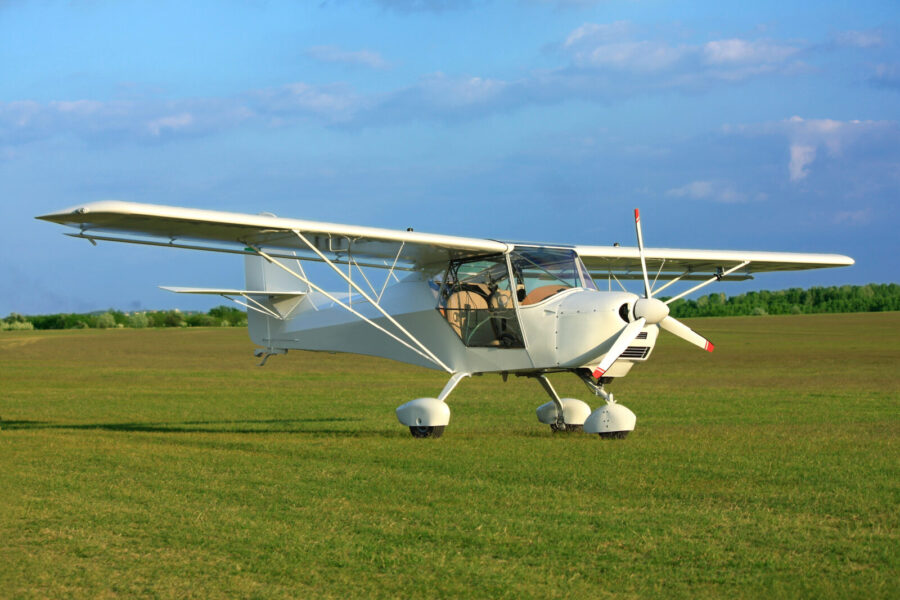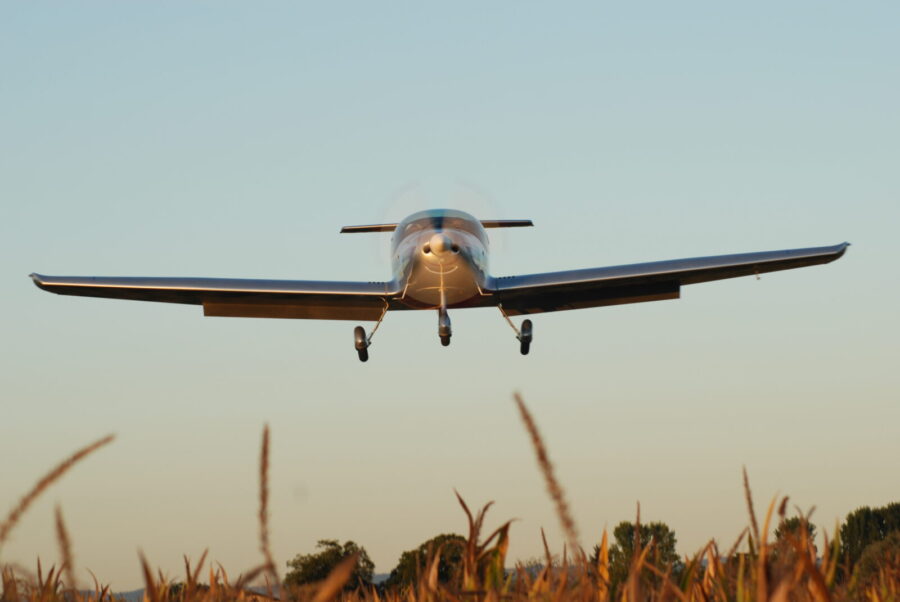Are Ultralight Aircraft Safe?
8 May 2023 | Updated on February 05, 2024
Ultralight vehicles are small and lightweight recreational vehicles popular among hobbyist flyers desiring fun, simple airborne pleasures. Almost anyone could fly an ultralight in the United States due to relaxed Federal Aviation Authority FAA regulations, which do not mandate a certificate of airworthiness for ultralight vehicles nor require training and certification for ultralight pilots.
As a result, over eighteen thousand ultralight vehicles are flying within the United States. Ultralight’s low costs have made them attainable to a much larger demographic than general aviation aircraft owners. Unfortunately, there has been a rising frequency of ultralight accidents in recent years, making most people assume that ultralights are mainly unsafe.
Read on as we answer your questions on ultralight safety and explore the factors responsible for ultralight accidents. Also, we see if the FAA needs to issue rules mandating pilot training and ultralight vehicle certification and if those rules can make ultralight aircraft safer.


How safe are ultralights?
Flight operations in any aircraft type, including ultralight vehicles, have an acceptable level of risk. Generally, ultralight aircraft are safe when competent pilots fly them within the limits of their design and capabilities. But ultralight safety is a matter of perspective, and most people view ultralight vehicles as flimsy contraptions flown by unlicensed mavericks with little regard for safety and aviation rules. The opinion is reinforced by the minimalist design of experimental aircraft and the perceived lack of regulation for ultralight aviation.
In reality, ultralight aircraft safety records fare better than other aircraft types, including general aviation. And the argument for ultralight vehicles being death traps crumbles when comparing data on aircraft accidents and fatality rates against general aviation aircraft accidents and fatalities.
Below is a table comparing ultralight vehicles and general aviation aircraft accidents and fatalities in Canada within a ten period from 1987 to 1996. We published data from the Accident data from the Transportation Safety Board of Canada because of inadequate ultralight accidents and fatalities records in the United States and the similar regulations guiding ultralight operations in both countries.
| Year | Ultralight Accidents | General Aviation accidents | Ratio – No of registered ultralights per accident | Ratio – No of GA aircraft registered per accident | Accident Rate per ultralight registered | Accident Rate per GA aircraft registered |
| 1987 | 42 | 472 | 1:70 | 1:47 | 0.014 | 0.021 |
| 1988 | 29 | 497 | 1:107 | 1:45 | 0.009 | 0.022 |
| 1989 | 37 | 482 | 1:86 | 1:47 | 0.012 | 0.021 |
| 1990 | 36 | 498 | 1:93 | 1:45 | 0.011 | 0.022 |
| 1991 | 39 | 453 | 1:89 | 1:49 | 0.011 | 0.021 |
| 1992 | 41 | 435 | 1:88 | 1:50 | 0.011 | 0.020 |
| 1993 | 50 | 422 | 1:75 | 1:51 | 0.013 | 0.020 |
| 1994 | 36 | 380 | 1:107 | 1:56 | 0.009 | 0.018 |
| 1995 | 44 | 390 | 1:90 | 1:54 | 0.011 | 0.018 |
| 1996 | 28 | 335 | 1:145 | 1:63 | 0.007 | 0.016 |
| Average | 38.2 | 364.4 | 1:95 | 1:51 | 0.011 | 0.020 |
In 1987, one ultralight accident for every 70 ultralight flights resulted in an accident rate of 0.014. Fast forward ten years to 1996, and one ultralight crash for every 145 ultralight flight operations resulted in an accident rate of 0.007. In comparison, general aviation aircraft’s accident rate for 1987 was one accident per 47 flights resulting in a 0,021 accident rate, and one accident for every 63 flights in 1996, leading to an accident rate of 0.016.
There are some reasons ultralights are relatively safe compared to general aviation airplanes:
- Slow maximum speed limitations of 40 mph (65 km/h) mean any fatal impact during a crash landing is doubtful.
- Simple and easy-to-operate controls.
- Minimal equipment, construction, and fewer moving parts mean potential component failure is less likely.
- Ultralights weigh considerably less than conventional airplanes making them more maneuverable and responsive to pilot controls than heavier airplanes during emergencies.
- Contrary to popular opinion, ultralight aviation is subject to strict government regulations for its class. These include weight requirements and performance standards.


What factors determine ultralight aircraft safety?
Several factors will contribute to your safety as you prepare to take your ultralight aircraft airborne. Some factors like environmental-related factors are common risks associated with ultralight flights, which pilots must consider before getting airborne. Other factors may occur with little warning creating problems during flight operations and rendering your ultralight inoperable or with limited flight or landing capabilities. Ultralight flight operations aren’t necessarily more dangerous than flying regular airplanes. Still, we recommend that pilots acquire enough training and experience to prevent seemingly mundane incidents from turning into full-blown catastrophes.
Below are some factors determining ultralight flight safety:
- Weather – is crucial in aviation, affecting both large and small airplanes. Ultralight aircraft are more susceptible to extreme weather conditions, and flights can get really bouncy in stormy and gale-force wind conditions. Weather is an environmentally related factor that pilots can avoid by staying on the ground.
- Pilot error – is a common cause of ultralight accidents and a primary reason ultralight aircraft are deemed unsafe by the public. Inexperienced pilots account for most ultralight aircraft accidents, and their inadequate training prevents effective responses to emergencies. A study also reveals pilots involved in those crashes often overlook pre-flight inspections or ignore weather warnings before embarking on their fatal flight.
- Fuel starvation – is when you run out of fuel mid-flight. It often occurs when pilots are preoccupied with numerous maneuvers, including landing and take-off. Sometimes, pilots can enjoy the scenery too much and forget to check their fuel reserves.
- Bird strikes – wildlife accidents are a threat to airplanes, but a strike on an open cockpit ultralight can be fatal if the pilot is knocked unconscious by a direct bird strike. There are reports of emergency landings from birds ripping ultralight fabric wing covers on impact and aircraft being wrecked from hitting a deer during landing.
- Poor design – ultralight with poor design features resulting in component failure or poor handling can lead to accidents when inexperienced pilots fly.
Does pilot skill play a part in ultralight safety?
Pilot error is by far the most common cause of ultralight aircraft accidents. As said above, pilots who understand the limitations of ultralight aircraft fare much better than pilots with little understanding of ultralight flight dynamics, including takeoff and landing procedures.
Modern ultralights are highly forgiving of mistakes, but even professional pilots who transition into ultralights from heavier airplanes without the proper training may soon find themselves in trouble. Ultralight aircraft’ lightweight design and slow speeds mean sudden changes in weather conditions can significantly affect performance and handling. And hobbyist flyers without considerable flight experience are prone to misjudgments resulting in tragedy.
As an ultralight pilot, it is your responsibility to make flights safer. Below are some things you must do to achieve this:
- Devote enough time for training and practicing flying your ultralight.
- You must make excellent preparations before each flight to reduce the odds of crashing. These include.
- Getting information about your destination and flight route.
- Preparing a flight plan or itinerary.
- Checking weather conditions along your flight path.
- Performing pre-flight checks on the engine, airframe, and control systems.
- Planning your take-off procedure.
- Planning your cross-country procedure.
- Planning your landing procedure.
- All ultralight pilots must understand their aircraft well, including maintaining and running the 2-stroke engine commonly fitted to ultralight aircraft.


Does an ultralight construction make it unsafe?
At first glance, an ultralight might look like an accident waiting to happen. The bare aluminum frames, exposed control cables, the tiny two-stroke engine, and flimsy wing and tail fabrics look unlike any other aircraft. You wouldn’t pay most people to sit inside one, much less fly.
However, instances where manufacturing or design flaws, including negligent construction, are responsible for ultralight crashes are rare. Highlighting the massive improvements in ultralight design and build quality in recent decades is vital. Also, reputable and well-known manufacturers produce ultralights with better build quality and safety features, like a ballistic parachute system protecting the pilot during a crash.
Common safety concerns about ultralights
Ultralight aircraft have their shortcomings, just like conventional airplanes.
Here are some common safety concerns:
- Low-altitude flight operations – ultralight aircraft fly at lower altitudes, increasing a pilot’s chances of hitting power lines, communication towers, trees, or tall buildings.
- Lack of strict regulations – ultralight aircraft’s hobbyist and self-regulatory nature primarily attract pilots with little flying experience and skills who are likelier to commit blunders resulting in crashes.
- Skeletal construction – ultralight aircraft skeletal construction offers minimal crash protection and lacks the rigidity and crashworthiness of more robust conventional airplanes.
- Lack of emergency equipment – ultralights are not required to have emergency locator beacons or any other emergency equipment enabling speedy rescue after a crash. Pilots can die from injuries or exposure even if they survive the crash.
- Size – ultralight aircraft are not much bigger than a standard motorbike, and they are barely visible to pilots in other aircraft during foggy or cloudy weather conditions.
- Lack of air traffic oversight – federal aviation rules in the United States do not require ultralight aircraft to announce their position to air traffic control. Although ultralights are legally restricted to remote areas with minimal air traffic to prevent them from getting in the way of larger airplanes. There is always the danger of collision with other aircraft.
- Engines – ultralight aircraft are powered by 2 or 4-stroke engines that can be problematic during flight operations. The demanding nature of these engines often results in mid-air engine failure resulting in disastrous consequences if an inexperienced pilot is at the helm.
- Navigational equipment and cockpit display – ultralights with an open cockpit design have only essential gauges like an altimeter or engine rev counter. A major safety issue is a lack of navigation equipment or even a fuel gauge.
What is the role of maintenance in ultralight safety?
Ultralight vehicles operating in the United States are not subject to federal aircraft certification and maintenance standards. Consequently, it is your responsibility to keep your ultralight airworthy and safe. Ultralight pilots need little incentive to perform necessary frame inspections, system checks, and engine maintenance because a mid-air component or engine failure could mean certain death.
Developing a proper attitude towards maintenance helps to improve the safety of ultralight flight operations. Joining a local Experimental Aircraft Association (EEA) offers new ultralight owners an opportunity to receive maintenance tips and assistance from more experienced enthusiasts.


Are new ultralight vehicles safer than used ones?
Newer ultralight vehicles are safer than older models thanks to ultralight design and construction technology developments. New ultralight models are generally built with more durable materials and have more safety features than previous models. Plus, they hold their value over used models over time.
Eventually, pilots may find themselves making a compromise between safety and costs. Well-built and properly maintained ultralight models are just as safe as newer models, and they cost less to purchase and run, which is a significant advantage. It is not uncommon for older pilots to prefer specific used ultralight models over newer offerings.
Remember, the safest ultralight is a properly maintained example.
What to do if an ultralight crash occurs?
Airplane crashes are inevitable in aviation, and ultralight aircraft are no exception. Your actions before and immediately after an ultralight will determine your survival chances. Ultralight aviation’s unique nature makes rescue efforts following an accident particularly complicated.
So, here is a list of what to do in an ultralight accident:
- Be calm and brace yourself for impact by assuming the position recommended during your flight training. DO NOT unbuckle your seatbelt.
- Ensure you have a good idea of your surroundings before going down. It is a good idea to memorize nearby landmarks that will guide you when you are on land.
- Call in your position before going down if you have a radio or cell phone.
- If you survive the crash, assess the situation by checking yourself for injuries and whether the ultralight is still flyable.
- Call for help on a radio or cell phone. You might turn on your emergency locator beacon if you have one.
- If your injuries prevent walking, find a comfortable spot and lay still nearby the aircraft until help comes.
- You can attract people by waving your hands or a flashlight if you have one.
Conclusion
The safety of any ultralight flight depends on a pilot’s ability to be aware of the factors influencing ultralight safety during flight. It means the pilot must have excellent pre-flight preparation, avoid bad weather conditions, and ensure top-notch ultralight maintenance. Pilot training is critical to having a safe flight; the more experience you have flying ultralights, the safer you are.

































